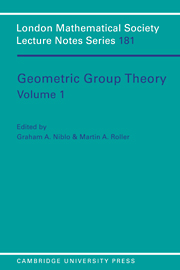Book contents
- Frontmatter
- Contents
- Preface
- List of Participants
- 1 Group Actions and Riemann Surfaces
- 2 The Virtual Cohomological Dimension of Coxeter Groups
- 3 The Geometric Invariants of a Group A Survey with Emphasis on the Homotopical Approach
- 4 String Rewriting — A Survey for Group Theorists
- 5 One Relator Products and High-Powered Relators
- 6 An Inaccessible Group
- 7 Isoperimetric and Isodiametric Functions of Finite Presentations
- 8 On Hibert's Metric for Simplices
- 9 Software for Automatic Groups, Isomorphism Testing and Finitely Presented Groups
- 10 Proving Certain Groups Infinite
- 11 Some Applications of Small Cancellation Theory to One-Relator Groups and One-Relator Products
- 12 A Group Theoretic Proof of the Torus Theorem
- 13 N-Torsion and Applications
- 14 Surface Groups and Quasi-Convexity
- 15 Constructing Group Actions on Trees
- 16 Brick's Quasi Simple Filtrations and 3-Manifolds
- 17 A Note on Accessibility
- 18 Geometric Group Theory 1991 Problem List
6 - An Inaccessible Group
Published online by Cambridge University Press: 15 March 2010
- Frontmatter
- Contents
- Preface
- List of Participants
- 1 Group Actions and Riemann Surfaces
- 2 The Virtual Cohomological Dimension of Coxeter Groups
- 3 The Geometric Invariants of a Group A Survey with Emphasis on the Homotopical Approach
- 4 String Rewriting — A Survey for Group Theorists
- 5 One Relator Products and High-Powered Relators
- 6 An Inaccessible Group
- 7 Isoperimetric and Isodiametric Functions of Finite Presentations
- 8 On Hibert's Metric for Simplices
- 9 Software for Automatic Groups, Isomorphism Testing and Finitely Presented Groups
- 10 Proving Certain Groups Infinite
- 11 Some Applications of Small Cancellation Theory to One-Relator Groups and One-Relator Products
- 12 A Group Theoretic Proof of the Torus Theorem
- 13 N-Torsion and Applications
- 14 Surface Groups and Quasi-Convexity
- 15 Constructing Group Actions on Trees
- 16 Brick's Quasi Simple Filtrations and 3-Manifolds
- 17 A Note on Accessibility
- 18 Geometric Group Theory 1991 Problem List
Summary
Introduction
Stallings [6] showed that a group G has more than one end if and only if G ≍ A*FB, where F is finite, A ≠ F ≠ B, or G is an HNN-extension with finite edge group F.
A finitely generated group G is said to be accessible if it is the fundamental group of a graph of groups in which all edge groups are finite and every vertex group has at most one end. We say that G is inaccessible if it is not accessible.
Let d(G) denote the minimal number of generators of the finitely generated group G. It follows from Grushko's Theorem that d(G*H) = d(G) + d(H). It follows that G is a free product of indecomposable groups, i.e. groups which cannot be written as a non-trivial free product. The problem of accessibility is whether we can replace the free product with free product with finite amalgamation in the last statement. (The number of HNN-decompositions is bounded by d(G).) However, there is no analogue of Grushko's Theorem. In fact, if G is accessible then any process of sucessively decomposing G, and the factors that arise in the process, terminates after a finite number of steps. See [2] for a proof of this and related results.
Linnell [5] proved that if G is finitely generated then, for any reduced decomposition of G as a graph of groups X in which all edge groups are finite, there is a bound B such that where E is the edge set of X.
- Type
- Chapter
- Information
- Geometric Group Theory , pp. 75 - 78Publisher: Cambridge University PressPrint publication year: 1993
- 22
- Cited by



